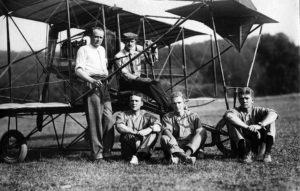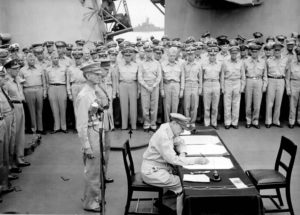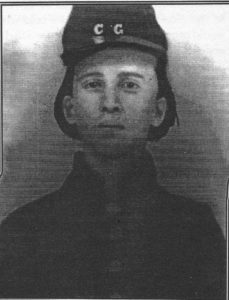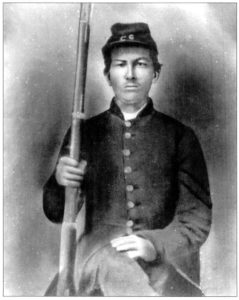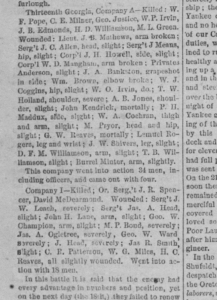If you are a student of US Naval Aviation, this 1911 photograph may be something like the holy grail.
Pictured is the Curtiss A-1 aircraft with Glenn H Curtiss at the wheel. Seated (L-R) are his students – young US Navy officers John Rodgers, John Henry Towers, and Theodore Ellyson – who qualified that summer as Naval Aviators #2, #3 and #1, respectively. The man standing at left is not identified, but is possibly Eugene Burton Ely (1879-1911), Curtiss’ pilot and a pioneer of Naval Aviation in his own right – the first man to take off from and land on a ship.
All of these men had tremendous flying stories and family histories – well worth a look when you have the time.
Rodgers (USNA 1903) and Ellyson (USNA 1905) were killed in plane crashes, in 1926 and 1928 respectively, but Towers (USNA 1906) had a 45-year Navy career culminating in 4-star Admiral’s rank (1945) and command of the US Pacific Fleet (1946).
Here’s Vice Admiral Towers (arrow) in a famous photograph of General Douglas McArthur signing surrender documents aboard USS Missouri (BB-63) in Tokyo Bay on 2 September 1945.
Bringing this back home …
Towers’ grandfather, Colonel John Reed Towers, commanded the 8th Georgia Infantry from 2nd Manassas to Appomattox, including in action with G.T. Anderson’s Brigade in the West Woods and on Piper’s Farm at Sharpsburg on 17 September 1862.
Here’s Colonel J.R. Towers, just after the Civil War.
Colonel Towers’ 2nd son and Admiral Towers’ father, William McGee Towers (1846-1912), was also a Confederate veteran. He served as an 18 year old cavalryman with General N.B. Forrest in 1864 and 1865. He lived to see his son fly.
___________________
Notes
More details of Admiral Towers’ Navy career are in a bio sketch from the Naval History and Heritage Command.
They are also the source of the Curtiss photograph above.
The 1945 photograph on the USS Missouri is online from the US National Archives.
The portrait of Colonel John R Towers is thanks to family genealogists via RootsWeb.
William D and Charles A Mangham (c. 1861)
5 May 2022
Brothers Charles A. (left) and William Decatur Mangham enlisted together as 2nd and 3rd Corporal, respectively, in the “Confederate Guards” – Company A, 13th Georgia Infantry – in July 1861, and had their pictures taken in their new uniforms.
Will was badly wounded in the arm at Sharpsburg on 17 September 1862 and served afterward as a Lieutenant in a Reserve Company assigned as guards at Andersonville, GA.
Charles’ photograph is from Oh, For a Touch of the Vanished Hand (2000) by Col. Dana Mangham, who says Charles was also wounded at Sharpsburg. I’ve not found other evidence of that. Will’s picture is from Rosalee Mangham King as published in Rachel McDaniel’s Pike County (2011).
In a related find, here’s a Sharpsburg casualty list for Companies A and I of the 13th Georgia clipped from page 4 of the Savannah Weekly Republican of 4 October 1862.
The complete edition of that paper is online from Georgia Historic Newspapers, and it also contains extensive descriptions of the action at Sharpsburg and has similar lists for the 12th, 50th, and 61st Georgia, and 5th Florida Infantry (along with lists for the 9th and 11th Georgia at Manassas).
William P Irvin (c. 1861)
3 May 2022
This fierce-looking young man is William Pinkney Irvin of Pike County, GA, and he probably posed for this picture shortly after he enlisted in Company A of the 13th Georgia Infantry in July 1861 at about 18 years old.
Sadly, he only got another year older. He was killed at Sharpsburg, MD on 17 September 1862.
This photo was shared by Rachael Weitnauer of Atlanta to accompany Keith S. Bohannon’s essay in The Antietam Campaign (1999), edited by Gary W Gallagher.
